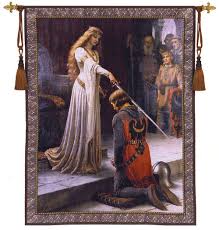Blast from the Past of Medieval Knights!
Wednesday, May 18, 2011
Tuesday, May 17, 2011
Knights in action!
In medieval times, knights were almost like soldiers, they fought for something and that something was their country, the difference, horses, jousting, swords, armor, fighting in a specific religion, type of attack method and the list goes on. All knights fought under god and they were all Christians. They also fought loyally under their king. They fought with honor and pride, and those to feelings were usually a good motivation for success.
Knights were expected to be polite, helpful, and respectful to others, especially women. Knights received either through battle or through payment, land, treasure, and castles. Knights went to battle equipped with their horse and weapon of choice for the battle field. Hey, here's a little fun fact for ya, jousting for sport and entertainment actually came from knights and their trusty steed!
The steps of the future knight
Before I started to know more about knights, I personally thought that knights were just men or young adults who had a choice of going into battle without training or a level of skill; but now I know that, that definitely is wrong logic on my part. The knight steps to success started at a very young age and didn't end 'till the knight in training was a young adult. Knights were meant to be disciplined before any type of knight task, so the plan must have been to do get that taken care of before they were even teenagers.
 There were three steps to becoming a knight, and each step was more difficult than the last. The page, the 1st phase of a knight's steps, the page was meant to run errands, learn respect like manners, and read beautiful poetry. This phase started around the age of seven and took away from things unique to children like drawing or friends that weren't knights.The squire, the 2nd phase of a knight's steps, the squire's job started around the age of 14. Squire's jobs were to look over weapons, armor, and a knight's horse.
There were three steps to becoming a knight, and each step was more difficult than the last. The page, the 1st phase of a knight's steps, the page was meant to run errands, learn respect like manners, and read beautiful poetry. This phase started around the age of seven and took away from things unique to children like drawing or friends that weren't knights.The squire, the 2nd phase of a knight's steps, the squire's job started around the age of 14. Squire's jobs were to look over weapons, armor, and a knight's horse.
Finally, the final step to becoming a knight was the knight's dubbing. Dubbing involved the queen, king, prince etc. to wave a sword around a knight's head, touching lightly on each shoulder and the knight in training officially became a knight. This phase usually took place when the future knight was a young adult and was ready for the final step to knighthood. After the dubbing, the knight was officially able to fight for his country and received the average treatment from others as a fellow knight.
Knights and their "clothes".
To explain the armor, well it was just a full plate of armor, sometimes iron that covered your feet to your hair(if they had any). Well of course there was a way to breath inside the helmet or it wouldn't really be a good protection tool now would it. The helmet had little slit that could slide up and down for you to see and an airway for your nose and mouth.
The fearless knights' weapons of choice.
Even though knights had a wide variety of punishing tools, the wide variety wasn't necessarily always there. Different weapons were invented at different time periods. In the 1400's, the mace was a popular tool to wield in Northern Europe. They're were many many weapons to a knight's eyes, like the sword,axe, and maces were three of them and there were many more to go with.
Subscribe to:
Posts (Atom)